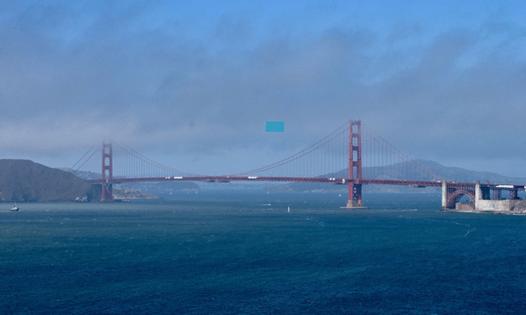Tom Philp: San Francisco uses the ocean as its toilet and wants to flush a key environmental law
Published in Op Eds
San Francisco has long used the Pacific Ocean as its toilet. In heavy rains, the city on the hill cannot store all the storm runoff and sewage that flows toward an oceanside treatment plant in a single old pipe, so some heads out to sea. Now, in a case with national implications, San Francisco is hoping that the U.S. Supreme Court will allow it to pollute the ocean on occasion without violating the federal Clean Water Act.
Although San Francisco has lived under this regulatory construct for decades, it has now decided to test the limits of federal regulations with a right-leaning high court known for restricting environmental laws.
It is beyond ironic that San Francisco is normally the favorite punching bag of America’s right, with Florida’s Ron DeSantis once showing a map of homeless defecation sites in the city while debating California’s Gavin Newsom. Yet now, San Francisco is trying to take advantage of this infamously right-tilted court.
While the city denies its legal challenge has anything to do with how Donald Trump fundamentally shifted this court during his presidency, the timing speaks for itself. San Francisco is a regressive city when it comes to all things water.
It is California’s Trumpsville.
No less than 12 other states are fighting San Francisco in court. So is California Attorney General Rob Bonta. So is the Biden administration, which has taken San Francisco to court alleging years of failure to upgrade a wastewater system dating back to the 19th century.
But San Francisco doesn’t seem to care. All it wants is five black-robed justices back in Washington, D.C. to eliminate some regulations. And given the court’s oral arguments earlier this month, San Francisco may be on its way to weakening environmental protections for the rest of the nation.
“We know that San Francisco’s system is resulting in 196 million gallons of sewage poured onto San Francisco’s beaches,” argued Frederick Liu, an attorney for the federal Environmental Protection Agency. “We know that it’s leading to sewer backups into homes and businesses. We know that their infrastructure is aging and failing. We know that the discharges are leading to excessive concentrations.”
Is San Francisco really the victim?
Yet San Francisco considers itself the victim.
“San Francisco is therefore exposed to crushing criminal and civil penalties even when it otherwise complies with its 300-page permit,” argued city attorney Tara Steeley. “It doesn’t tell permit holders in advance what we must do to control our discharges.”
San Francisco water management reeks of arrogance.
The system starts by storing water in Yosemite National Park’s Hetch Hetchy valley, a glacially-carved wonder that is now under water. The pristine snowmelt then flows to the city. There, after San Franciscans flush their toilets, precious little of the water is reused via recycling, a huge missed opportunity. Rather, the treated wastewater ends up either in San Francisco Bay or the Pacific when it isn’t raining. When it pours, the system can discharge untreated sewage.
Sacramento is the other major California city with a similar “combined” system, with one pipe for both stormwater and sewage in the inner city. But Sacramento is not in court over its permit. It treats “virtually” all its sewage prior to discharge in the Sacramento River.
It is San Francisco’s oceanside plant, the one that simply can’t adequately treat the waste of a quarter million San Franciscans when it rains, that is the subject of the litigation. The plant discharges at seven locations near shore and one 3.3 miles into the ocean.
San Francisco embraces that the Clean Water Act has allowed regulators to prescribe numeric limitations to discharges and their constituents. But it objects to broad prohibitions to pollute, contaminate or create a nuisance, known in the case as “generic prohibitions.”
Supreme Court Justice Brett Kavanaugh seemed to be outraged at the thought.
Speaking to Steeley, Kavanaugh said, “You’re on the hook for millions of dollars and potential prison time even though you didn’t know what your obligations were ahead of time,” a problem “that’s rooted in the statute.”
No attorneys could cite an instance when a wayward wastewater operator ever faced the prospect of incarceration. Rather, Liu told the court that state and federal regulators had to resort to some broad permit conditions because San Francisco made it impossible to do otherwise.
“We were unable to include limitations of that tailoring in this permit because San Francisco deprived us of the very information we would need to do that,” Liu said.
Stonewalling leads to a lawsuit
Fed up with the stonewalling, state and federal agencies have sued San Francisco in hopes of forcing the city to modernize its wastewater system.
“The city since the mid-‘90’s has done virtually nothing to invest in improving its combined sewer system,” said Eric Buescher, an attorney for the environmental group San Francisco Baykeeper.
The lawsuit, now in its early stages, seeks to prohibit any further clean water violations as well as civil penalties. Steeley told the high court the penalties could be as high as $10 billion. Liu said they hadn’t been calculated. He is basically right, the reality is that the case is far from a verdict.
Liu seemed to stop the right-leaning judges in their tracks when he sketched the real-world impact of their gutting the Clean Water Act as San Francisco wants.
The EPA in 14 days has long approved permits for countless farmers and construction projects as long as they broadly promise to follow environmental law. If the courts force regulators to prescribe specific numeric discharge limitations for these routine permits, what now takes days could take months. And that would “undermine…the economy of small business owners,” Liu said.
Justice Samuel Alito seemed to wonder out loud whether federal regulators should continue to issue broad restrictions in these permits and when applicants with complex systems like San Francisco have “refused to provide the information.”
If the court reaches such a compromise, San Francisco’s own recalcitrance, to provide the information that the federal government says it does not have, would be its undoing.
San Francisco water management remains stuck in the 19th century by defending a wastewater system of that era. It could move into the 20th century by embracing as implemented the environmental laws of that era. And it could leap into the modern world by joining its urban water peers, particularly those in Southern California, by recycling that water from the Sierra over and over again. Diversifying its Sierra-centric water portfolio would reduce San Francisco’s dependence on Yosemite. Such a prospect is one that the city’s antiquated water orthodoxy has never managed to fathom.
The Pacific shouldn’t be San Francisco’s potty to foul as much as it can get away with.
California’s most infamous Trumpian city will remain so until it cleans up its water act in so many ways.
_____
©2024 The Sacramento Bee. Visit sacbee.com. Distributed by Tribune Content Agency, LLC.




























































Comments